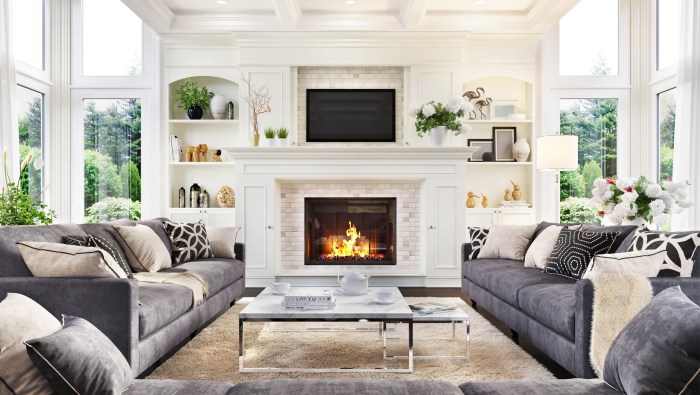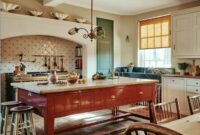Comparing different styles of luxury home interiors reveals a fascinating world of design choices. From the sleek minimalism of modern aesthetics to the rich opulence of traditional designs, the possibilities are endless. This exploration delves into five distinct styles – Modern, Traditional, Transitional, Farmhouse, and Minimalist – examining their unique characteristics, including furniture, materials, color palettes, and the overall ambiance they create.
We’ll also consider how architectural features, material textures, lighting, and carefully selected furnishings contribute to the distinct personality of each style, ultimately guiding you towards creating a truly luxurious and personalized living space.
Defining Luxury Home Interior Styles
Luxury home interiors offer a diverse range of styles, each reflecting a unique aesthetic and lifestyle. Understanding these styles allows homeowners to choose the perfect design to express their personality and create a truly exceptional living space. The key differences lie in the choice of furniture, materials, color palettes, and the overall atmosphere they evoke.
Five Distinct Luxury Home Interior Styles
The following table details five prominent luxury interior design styles, highlighting their defining characteristics. These styles, while distinct, can also be blended to create a personalized and sophisticated look.
| Style | Key Furniture | Materials | Color Palette |
|---|---|---|---|
| Modern | Sleek sofas, minimalist armchairs, clean-lined coffee tables, integrated storage | Glass, steel, concrete, polished wood, natural stone | Neutral base (white, gray, beige) with pops of bold color (emerald green, sapphire blue, deep red) |
| Traditional | Ornate sofas, wingback chairs, antique tables, statement mirrors, crystal chandeliers | Rich fabrics (velvet, silk, brocade), dark wood, marble, gilded accents | Warm, rich tones (cream, ivory, gold, deep reds, blues, greens) |
| Transitional | A blend of modern and traditional pieces, comfortable sofas with clean lines, elegant armchairs | Combination of modern and traditional materials; wood, stone, metal, and luxurious fabrics | Neutral base with pops of color; balances both warm and cool tones |
| Farmhouse | Reclaimed wood furniture, comfortable upholstered seating, vintage accents, exposed beams | Reclaimed wood, natural stone, linen, cotton, metal | Neutral and warm tones (white, cream, beige, gray) accented with natural wood tones |
| Minimalist | Simple, functional furniture, clean lines, multi-purpose pieces, lack of clutter | Natural materials (wood, stone, bamboo), neutral-colored fabrics | Neutral and monochromatic palette (white, gray, beige) |
Mood and Atmosphere Created by Each Style
Each style creates a distinct mood. Modern interiors often feel airy, spacious, and sophisticated. Traditional styles evoke a sense of timeless elegance and grandeur. Transitional spaces offer a comfortable blend of classic and contemporary. Farmhouse interiors are warm, inviting, and rustic.
Choosing between minimalist modern and opulent traditional? Comparing different styles of luxury home interiors can be overwhelming. But before you dive into design choices, consider the foundation: check out this guide on transforming a dated home into a luxurious space to ensure your vision is structurally sound. Then, you can confidently compare styles and select the perfect luxurious look for your newly renovated home.
Minimalist designs create a serene and uncluttered environment. The choice depends entirely on the desired feeling and functionality of the living space.
Comparing Architectural Features and their Impact
Architectural features play a pivotal role in determining the most suitable interior design style for a luxury home. The interplay between existing structure and desired aesthetic is crucial for creating a cohesive and luxurious living space. High ceilings, expansive windows, and the presence or absence of a fireplace, for example, dramatically impact the overall feel and the style choices available.The relationship between architecture and interior design is symbiotic; one informs and enhances the other.
Understanding this relationship allows for the creation of a truly harmonious and luxurious living environment. Ignoring this can lead to clashes in style and a less-than-optimal outcome.
Architectural Features and Style Suitability
High ceilings, a hallmark of many grand homes, lend themselves well to styles like Traditional, Modern, and even some interpretations of Industrial design. The grandeur of high ceilings allows for dramatic statement pieces, like large chandeliers or sculptural light fixtures, which are less effective in homes with lower ceilings. Conversely, low ceilings might necessitate a more minimalist approach to avoid overwhelming the space.
Large windows, flooding a room with natural light, often pair well with contemporary and minimalist styles that emphasize clean lines and a connection with the outdoors. These styles often utilize light, neutral color palettes to complement the natural light. In contrast, Victorian or traditional styles, while they can incorporate large windows, might prefer heavier drapes and richer colors to create a sense of warmth and intimacy.
The presence of a fireplace, a classic focal point, can dictate the overall style of a room. A grand, ornate fireplace might suggest a traditional or even a rustic style, whereas a sleek, modern fireplace could complement a contemporary or minimalist aesthetic.
Luxury Styles in Different Architectural Designs
A Victorian home, with its intricate detailing and often smaller rooms, might be best suited to a Traditional or perhaps even a slightly eclectic style that embraces the home’s existing character. The ornate moldings and high ceilings of a Victorian home can be enhanced, not overwhelmed, by a traditional style with rich fabrics, period-appropriate furniture, and warm color palettes.
A Ranch style home, known for its open floor plan and connection to the outdoors, often pairs well with contemporary or transitional styles. The emphasis on clean lines and functionality inherent in Ranch architecture is complemented by the minimalist aesthetic of contemporary design, or the blend of traditional and modern elements found in transitional style. Contemporary homes, with their clean lines and open spaces, are a natural fit for minimalist or modern styles.
Choosing the right luxury interior style can be tricky! From minimalist modern to opulent traditional, the options are vast. If you’re focusing on the living room, a great resource is this guide on creating a sophisticated living room with luxury elements to help you decide which elements work best for you. Ultimately, comparing these different styles helps you pinpoint your perfect luxury home aesthetic.
The lack of ornamentation in contemporary architecture allows the interior design to take center stage, showcasing high-quality materials and simple, elegant forms.
Hypothetical Luxury Home Design
Imagine a luxury home with the following architectural features: a grand entrance hall with a double-height ceiling, large windows overlooking a landscaped garden, a central fireplace in the living room with a reclaimed wood mantel, and a modern open-plan kitchen. The architectural style could be described as a blend of modern and traditional elements, emphasizing clean lines and natural materials.
Given these features, a transitional interior design style would be particularly suitable. The high ceilings and fireplace would allow for the incorporation of traditional elements such as rich fabrics, ornate lighting fixtures, and antique accents. Meanwhile, the open-plan layout and large windows would allow for the integration of modern elements such as sleek furniture, minimalist decor, and a neutral color palette.
This blend creates a luxurious space that is both elegant and functional, respecting the existing architecture while creating a cohesive and stylish interior.
Material and Texture Comparisons
The choice of materials and textures is paramount in defining the character of a luxury home interior. Different styles leverage various materials to achieve their unique aesthetic and evoke specific moods and feelings. Understanding these material choices and their textural impact is key to appreciating the nuances of each design approach.The interplay of materials and textures significantly impacts the overall ambiance of a luxury space.
A minimalist design might prioritize the smooth, cool feel of polished concrete and the sleekness of brushed steel, while a traditional style might favor the warmth and richness of richly grained wood and plush velvet upholstery. These contrasts demonstrate how carefully selected materials can either enhance or detract from the intended atmosphere.
Material and Texture Use in Luxury Interior Styles
The following table compares the use of materials and textures across three distinct luxury interior styles: Modern Minimalist, Classic Traditional, and Art Deco. Each style utilizes materials in a way that reflects its core design principles and creates a unique sensory experience.
| Style | Material | Texture | Overall Feel |
|---|---|---|---|
| Modern Minimalist | Concrete, Steel, Glass, Leather | Smooth, Polished, Sleek, Cool | Clean, Uncluttered, Sophisticated, Serene |
| Classic Traditional | Wood (Oak, Mahogany), Marble, Silk, Velvet | Richly Grained, Smooth, Polished, Soft, Plush | Warm, Luxurious, Elegant, Inviting |
| Art Deco | Chrome, Lacquer, Velvet, Marble, Wood veneer | Glossy, Smooth, Polished, Soft, Textured | Glamorous, Opulent, Dramatic, Geometric |
Color Palette Analysis Across Styles
Color is a powerful tool in luxury interior design, capable of dramatically altering the mood and feel of a space. The strategic use of color palettes is crucial in defining and reinforcing the character of each distinct style, creating a cohesive and luxurious atmosphere. Different styles leverage color in unique ways, reflecting their historical influences and intended aesthetic.Color choices contribute significantly to the distinct character of each luxury interior style by evoking specific emotions and associations.
A cool, muted palette might suggest a sense of calm sophistication, while a warm, vibrant palette could project energy and opulence. The interplay of light and shadow further enhances the impact of color, highlighting textures and creating visual depth.
Examples of Color Palettes in Luxury Interior Styles
Several luxury interior styles exhibit recurring color palettes. For instance, traditional styles often favor rich, jewel-toned hues like deep blues, emerald greens, and burgundy reds, complemented by creams and golds. Modern styles, on the other hand, frequently employ a more restrained palette featuring neutral tones such as grays, whites, and blacks, accented with pops of vibrant color. Contemporary styles might incorporate bolder color combinations, playing with unexpected juxtapositions and monochromatic schemes.
Minimalist designs often stick to a limited palette of neutral colors to maintain a sense of spaciousness and serenity.
Deciding on a luxury interior style can be tough! From minimalist chic to opulent baroque, the choices are vast. If you’re drawn to a more unique, layered approach, check out this amazing resource for luxury interior design inspiration for eclectic homes to get ideas. Ultimately, comparing different styles helps you pinpoint the perfect luxurious feel for your home.
Three Example Color Palettes
Below are three distinct color palettes, each representative of a different luxury style.
Comparing different styles of luxury home interiors, from minimalist modern to opulent traditional, can be fascinating. But achieving that high-end look doesn’t always mean breaking the bank; check out this guide on how to achieve a luxurious interior design on a budget for clever tips and tricks. Then, armed with these savvy strategies, you can confidently compare and choose the perfect luxurious style for your home, even on a tighter budget.
- Traditional Elegance: This palette centers around warm, inviting tones. Imagine deep emerald green walls, accented by cream-colored millwork and furnishings upholstered in rich burgundy velvet. Gold accents, perhaps in the form of gilded picture frames or decorative hardware, add a touch of opulence. This palette evokes feelings of comfort, history, and timeless sophistication. The emotional impact is one of warmth, security, and a sense of established wealth.
- Modern Minimalism: This palette prioritizes clean lines and simplicity. Picture cool gray walls, complemented by crisp white accents and sleek black furniture. A single, bold pop of color, perhaps a vibrant teal in a piece of artwork or an accent pillow, adds visual interest without disrupting the overall sense of calm. The emotional impact is one of serenity, order, and sophisticated restraint.
The overall feeling is one of calm, efficient elegance.
- Contemporary Chic: This palette is characterized by a bold juxtaposition of colors. Imagine a base of deep charcoal gray walls, paired with bright, saturated hues like sunshine yellow and coral. Metallic accents, such as brushed brass or copper, add a touch of industrial-chic flair. The emotional impact is one of energy, excitement, and unexpected sophistication. It suggests a personality that is both confident and playful.
Lighting and its Role in Defining Ambiance
Lighting is paramount in shaping the atmosphere of a luxury home interior. It’s more than just illumination; it’s a crucial design element that dictates mood, highlights architectural details, and enhances the overall aesthetic of the space. The careful selection and placement of lighting fixtures, combined with strategic lighting techniques, can transform a room from ordinary to extraordinary.
Lighting Fixture Choices Across Luxury Styles
Different luxury interior styles utilize distinct lighting fixtures to create their unique ambiance. For instance, a classic, traditional style might feature elaborate crystal chandeliers as a central focal point, casting a warm, romantic glow. These chandeliers often complement ornate wall sconces and table lamps with similar detailing. In contrast, a minimalist modern design might favor sleek, recessed lighting, supplemented by strategically placed pendant lights over kitchen islands or dining tables.
These pendant lights often showcase minimalist geometric designs and are made of materials like brushed steel or polished chrome. A contemporary style might incorporate a mix of these approaches, perhaps with statement pendant lights over a seating area and recessed lighting elsewhere for more subtle illumination. Art Deco styles might opt for geometrically shaped lamps with metallic accents and possibly some use of neon lighting for a dramatic effect.
Choosing a luxury interior style can be tricky! Comparing minimalist modern designs to opulent baroque styles reveals vastly different approaches. But even with grand visions, understanding space is key, which is why checking out top luxury interior design trends for small spaces is helpful. This knowledge helps you adapt larger-scale design elements to suit smaller footprints when comparing different luxury styles.
Ultimately, the best style depends on your personal taste and the space you have available.
Ambient, Task, and Accent Lighting Techniques
Effective lighting design in luxury interiors often employs a layered approach combining ambient, task, and accent lighting. Ambient lighting provides overall illumination, setting the general mood of the room. In a traditional setting, this might be achieved primarily through a large chandelier, while a modern space might rely more heavily on recessed lighting or track lighting. Task lighting focuses on specific areas requiring focused illumination, such as reading nooks, kitchen countertops, or vanities.
This could include adjustable desk lamps, under-cabinet lighting, or strategically placed pendants. Accent lighting is used to highlight specific architectural features, artwork, or decorative objects. This could involve spotlights directed at a sculptural piece, uplighting to emphasize tall ceilings, or strategically placed wall sconces to draw attention to a fireplace mantel.
Lighting Scenarios and Their Effects, Comparing different styles of luxury home interiors
Consider a luxurious master bedroom designed in a contemporary style. Ambient lighting might be provided by recessed lights in the ceiling, creating a soft, even glow. Task lighting could be incorporated with adjustable bedside lamps, allowing for comfortable reading. Accent lighting could highlight a statement piece of artwork above the bed or subtly illuminate a textured wall. The combined effect is a calm, sophisticated atmosphere conducive to relaxation.
In contrast, a formal living room in a traditional style might use a grand crystal chandelier as the primary ambient light source. Table lamps and floor lamps would provide additional task and ambient lighting. Accent lighting could highlight architectural moldings or a collection of antique porcelain. This creates a warm, inviting, and grand atmosphere, perfect for entertaining guests.
A minimalist living room might utilize a combination of recessed lighting and carefully positioned linear pendant lights. This combination offers both ample ambient and task lighting, while the clean lines of the fixtures maintain the minimalist aesthetic. In a glamorous Art Deco space, ambient lighting could be achieved through a combination of a geometric chandelier and wall sconces, with accent lighting highlighting mirrored surfaces and metallic finishes.
Task lighting would likely be provided by elegant table lamps with decorative bases. The overall effect is one of luxurious sophistication and dramatic flair.
Furnishings and Decor: Comparing Different Styles Of Luxury Home Interiors

Source: decoraid.com
The careful selection of furnishings and decorative elements is paramount in achieving a cohesive and luxurious interior. Different luxury styles dictate specific aesthetic choices, impacting the overall feel and ambiance of the space. Understanding these nuances is crucial for creating a truly refined and stylish home. The following breakdown explores the characteristic furnishings and décor associated with several prominent luxury interior design styles.
Furnishings and Decor in Modern Luxury Interiors
Modern luxury interiors prioritize clean lines, minimalist aesthetics, and high-quality materials. The furniture is typically characterized by its sleek silhouettes, functional design, and sophisticated simplicity.
- Furniture: Think low-profile sofas with clean lines, streamlined armchairs in neutral tones, and minimalist coffee tables made from materials like polished chrome, glass, or lacquered wood. Pieces are often modular, allowing for flexibility and adaptability.
- Decorative Elements: Artwork is usually abstract or minimalist, with a focus on strong colors or textures. Rugs are often geometric or solid-colored, and accessories are kept to a minimum, emphasizing quality over quantity. Sculptural pieces or statement lighting fixtures can add visual interest.
Furnishings and Decor in Traditional Luxury Interiors
Traditional luxury interiors exude timeless elegance and opulence. Rich textures, ornate details, and classic silhouettes are key features.
- Furniture: Expect plush, oversized sofas and armchairs upholstered in luxurious fabrics like velvet or silk. Antique or antique-inspired pieces are common, featuring intricate carvings, gilded accents, and rich wood finishes. Large, statement pieces are often the focal point of the room.
- Decorative Elements: Artwork tends to be classic, featuring landscapes, portraits, or still lifes. Rugs are often patterned and richly colored, adding warmth and texture. Accessories may include ornate mirrors, crystal chandeliers, and decorative objects made from fine materials like porcelain or silver. The overall effect is one of grandeur and sophistication.
Furnishings and Decor in Transitional Luxury Interiors
Transitional luxury interiors bridge the gap between traditional and modern styles, blending classic elegance with contemporary simplicity.
- Furniture: The furniture selection often incorporates elements from both traditional and modern styles. For instance, a classic Chesterfield sofa might be paired with a sleek, modern coffee table. Materials may include both natural wood and polished metals. The overall look is balanced and refined.
- Decorative Elements: Artwork can range from classic to contemporary, while rugs might feature both traditional patterns and modern color palettes. Accessories are carefully chosen to complement the mix of styles, creating a harmonious and sophisticated environment. The emphasis is on creating a balance between the formal and informal.
Furnishings and Decor and its Impact on Overall Coherence
The choice of furnishings and décor directly impacts the success of a luxury interior design. Inconsistent choices can detract from the overall aesthetic, while careful curation enhances the intended style. For example, placing a brightly colored, modern sculpture in a traditionally styled room might create a jarring visual conflict. Conversely, selecting furnishings and accessories that complement the architectural features and color palette reinforces the chosen style and elevates the overall design.
A well-curated selection of furnishings and decor ensures a harmonious and luxurious living space that reflects the homeowner’s personal style and taste.
Closing Summary
Ultimately, the choice of luxury home interior style is a deeply personal one, reflecting individual tastes and preferences. By understanding the nuances of each style – from the bold statements of modern design to the comforting familiarity of traditional aesthetics – you can make informed decisions to create a home that not only looks stunning but also feels perfectly tailored to your lifestyle.
This journey through diverse design elements has hopefully illuminated the path to crafting your ideal luxurious haven, a space where aesthetics and functionality harmoniously coexist.
Commonly Asked Questions
What is the difference between Transitional and Traditional styles?
Traditional styles are heavily ornate and classic, often featuring dark wood, rich fabrics, and symmetrical layouts. Transitional styles blend traditional elements with more modern, streamlined pieces, creating a balanced and less formal look.
How can I incorporate sustainable materials into a luxury home interior?
Sustainable luxury is achievable through choices like reclaimed wood, bamboo flooring, organic cotton fabrics, and ethically sourced stone. These materials offer both beauty and environmental responsibility.
What’s the best way to incorporate smart home technology into a luxury design?
Seamless integration is key. Choose technology that’s aesthetically pleasing and unobtrusive, such as hidden smart speakers, automated lighting systems, and discreetly installed smart thermostats.
How much does it typically cost to design and furnish a luxury home interior?
The cost varies drastically depending on the size of the home, the chosen materials, and the level of customization. It’s best to consult with interior designers and contractors for accurate estimates.
Are there any specific considerations for designing a luxury home interior in a smaller space?
Maximize light, use light colors and reflective surfaces to create an illusion of spaciousness. Choose multi-functional furniture and prioritize clean lines to avoid a cluttered feel.



